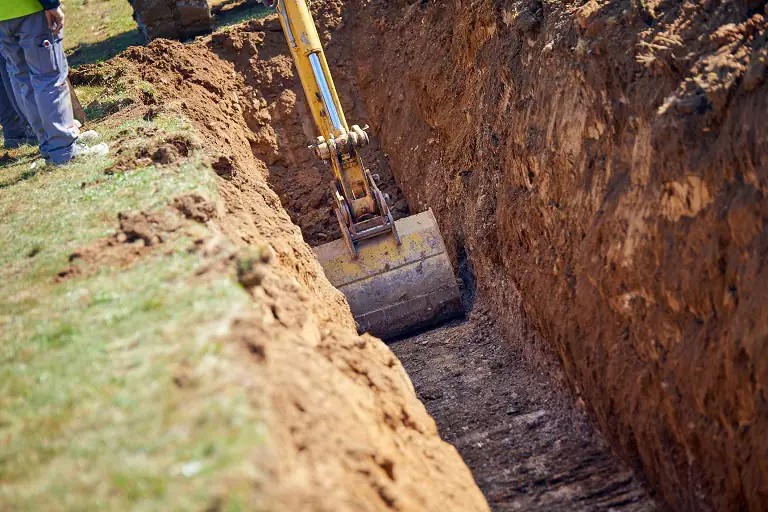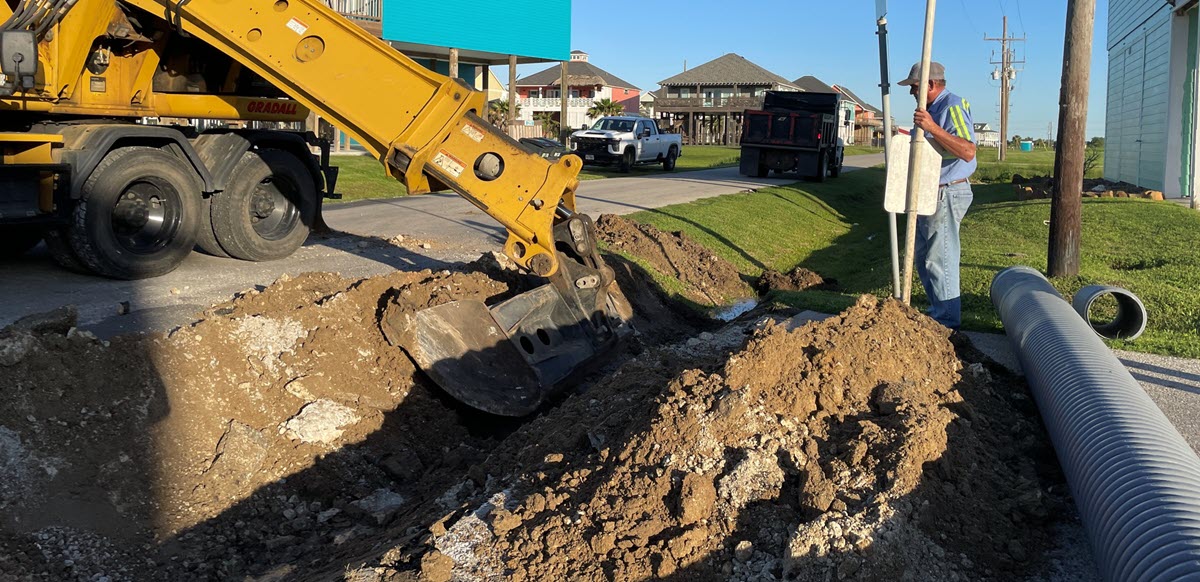Ditch Digging Servicesin Marine City MI
Precision Ditching for Effective Water Drainage
We Are Locally Owned & Operated For Over 37 Years
Contact Us Today!
We Serve Businesses In And Around The Following Cities:
About Ditch Digging Services
Ditching: An Indispensable Commercial Properties Endeavor in Marine City
Marine City, a thriving city filled with commercial properties of all shapes and sizes, is no stranger to the harsh impact of waterlogged seasons and the inevitable call for routine excavation. One essential service that keeps the city’s infrastructural engines humming smoothly is the vital practice of ditching. Recognizing the relevance of this service within the commercial property framework and understanding its underlying mechanism is the bedrock to maximizing its benefits. This comprehensive guide centers on the profound process of ditching in Marine City, exploring its benefits and real-world applications in commercial properties.
The Process of Ditching in Marine City
Ditching might seem straightforward – simply digging a trench in the ground, but in the world of commercial property, it is nothing short of an intricate chess game. The networks of utilities, sewage lines, or water supply pipes need careful attention and expert analysis by emerging and seasoned players alike, such as local service providers like D&J Contracting. Ditching services generally follow a systematic scheme: site assessment, planning, execution, and final inspection which ensure safe and effective results.
Ditching company provides not just the craftsmanship or heavy machineries for the digging itself, but more so the precise knowledge and expertise, ensuring your commercial property benefits fully from the ditching application. Employing a professional ditch excavation service such as D&J Contracting mitigates any possible risks, saves time, shields your property from avoidable mishaps, and ultimately offers peace of mind, assuring you that your utilities and infrastructure are in safe hands.
Why Ditching Matters: Unveiling the Benefits
Firstly, ditching plays a pivotal role in water management. Properly constructed ditches facilitate efficient stormwater management and prevent destructive consequences of flooding on commercial properties, especially during the waterlogged seasons in Marine City. Furthermore, ditching aids in creating channels for utility lines- electricity, gas, sewage-you name it!
A striking example of utility ditch digging’s value is the Marine City Business Park – before the development, the area faced consistent flooding and standing water. Employing ditching services radically transformed the landscape, allowing for successful business operation even during challenging weather conditions, and also paving the way for utilities to be safely and efficiently installed, connecting the park to the city’s lifeblood.
Selection of Ditching Professionals
When considering who to entrust your commercial property’s ditching needs to, local knowledge is rapidly gaining ground as an important criterion. By leveraging a “ditch digging services near me” strategy, you are not only supporting local businesses, such as D&J Contracting, but also gaining the added advantage of geographically relevant expertise, ensuring the ditching process is adapted perfectly to Marine City’s specific conditions.
P
rossessing the blend of global knowledge and local insights, D&J Contracting emerges as a competent player in this arena. They offer a wide range of ditching services, cementing their position as a one-stop solution for commercial property owners in Marine City.
Indeed, ditching operations’ costs might seem considerable upfront. But, when viewing these costs in terms of potential damage mitigation, the long-term value becomes clear. The expenditure becomes an investment towards crafting a commercial property able to withstand the test of time and weather conditions, ultimately providing an environment conducive for business operations.
We find ourselves circling back to the core perspective we started off with – recognising the real value of ditching. All elements combined, responsible ditching is a fundamental equation of responsible commercial property ownership, an equation best solved by relying on experienced local professionals such as D&J Contracting and benefiting from their specialized ditch excavation services.
As commercial property owners in Marine City, the decision is in our hands – to choose not just for today, but for a stable, efficient, and sustainable Marine City of tomorrow.
Ditch Digging Services Gallery


Call Us Today to receive your Free Quote for
Ditching in Marine City
Serving: Marine City, Michigan

About Marine City, Michigan
The area of Marine City had been Ojibwa territory for centuries before the first European contact. Beginning in the 17th century, French trappers and missionaries entered the territory, followed by settlers in the colonial period on both sides of the Detroit and St. Clair rivers. Farmers developed long, narrow plots that were laid out in the typical rectangular shape of colonial French, with the narrow end along the riverfront. The first Catholic Church was built by French Catholics at Catholic Point, where they had bought land before the United States was formed. French Canadians also lived on the other side of the river in a small farming community known as Petite Côte.
It was not until after the American Revolution that European-American settlers arrived in any number. In the 1780s they obtained a deed for land from the Chippewa Indians. The Americans began to call the community “Yankee Point”, because so many settlers came from the Northern Tier of states, with late 18th and 19th-century westward migration originating from New England and New York. They also called the settlement “Belle River” (Belle Riviere in French), as the French had; this later was applied as the name of a neighborhood.
The village was platted by Americans as Newport in 1835–37. Although never incorporated by that name, it was known as “Newport” for 31 years. In 1865, it was incorporated as the Village of Marine City. Thriving on lumber trade and shipbuilding, the village re-incorporated as a city in June 1887.
The second half of the 19th century was the period of great growth in the village, with many workers employed in the lumber and shipping industries. Rafts of lumber were moved down the St. Clair River in the spring to be worked at Marine City or Detroit. Shipyards built some of the many wooden ships that crossed the Great Lakes. Lake steamers linked passengers with small towns around the lakes. Their decks were full and their flags were flying. Marine City was centered on a park by the St. Clair River, where bands played in the bandstand at City Hall during the summer.
As the lumber business ran down with the exploitation of forests, the area became linked to other resource extraction. Freighters carried iron from Duluth, Minnesota, which had been mined in the Mesabi Range, to Ashtabula, Ohio for steel processing. They passed from Lake Superior through Lake Huron and to Lake Erie. Marine City was known as the town on the St. Clair River where the captains of lake freighters lived. Many of these men and their crews worked for the Pittsburgh Steamship Company. Formed in 1901 by US Steel Corporation, it became the largest commercial fleet on the Great Lakes.
In the 21st century, Marine City has become the home of ten antique stores. The Snug Theater is a 98-seat theater featuring live performances. It will be joined in 2014/15 by a sister theater, The Riverbank Theater, in a former bank building (originally Marine Bank & Trust) down the street. Also joining the two acting theaters is the old Mariner Theatre, which serves as a special event center, movie theater, gallery for fine art Models, and site of the builders model for the ocean-going Titanic. Restaurants and retail in downtown also cater to visitors and residents.
The Heather House, now operated as a bed and breakfast, was built in the Queen Anne Victorian-style. It was completed in 1885 after 2 years of construction for its owner, William Sauber. He was chief engineer for the Mitchell fleet of Great Lake steamers.
- According to the United States Census Bureau, the city has a total area of 2.46 square miles (6.37 km), of which 2.15 square miles (5.57 km) is land and 0.31 square miles (0.80 km) is water.
- It is considered to be part of the Thumb of Michigan, which in turn is a subregion of the Flint/Tri-Cities.
- Marine City can also be considered as in the Blue Water Area, a subregion of the Thumb.
- It is part of the Detroit-Warren-Livonia Metropolitan Statistical Area (MSA) and the Detroit-Ann Arbor-Flint Combined Statistical Area (CSA).
| Census | Pop. | Note | %± |
|---|---|---|---|
| 1870 | 1,240 | — | |
| 1880 | 1,673 | 34.9% | |
| 1890 | 3,268 | 95.3% | |
| 1900 | 3,829 | 17.2% | |
| 1910 | 3,770 | −1.5% | |
| 1920 | 3,731 | −1.0% | |
| 1930 | 3,462 | −7.2% | |
| 1940 | 3,633 | 4.9% | |
| 1950 | 4,270 | 17.5% | |
| 1960 | 4,404 | 3.1% | |
| 1970 | 4,567 | 3.7% | |
| 1980 | 4,414 | −3.4% | |
| 1990 | 4,556 | 3.2% | |
| 2000 | 4,652 | 2.1% | |
| 2010 | 4,248 | −8.7% | |
| 2020 | 4,079 | −4.0% | |
| U.S. Decennial Census | |||
As of the census of 2010, there were 4,248 people, 1,765 households, and 1,117 families residing in the city. The population density was 1,975.8 inhabitants per square mile (762.9/km). There were 2,015 housing units at an average density of 937.2 per square mile (361.9/km). The racial makeup of the city was 96.8% White, 0.3% African American, 0.7% Native American, 0.2% Asian, 0.5% from other races, and 1.6% from two or more races. Hispanic or Latino of any race were 1.7% of the population.
There were 1,765 households, of which 31.1% had children under the age of 18 living with them, 44.6% were married couples living together, 13.3% had a female householder with no husband present, 5.4% had a male householder with no wife present, and 36.7% were non-families. 31.3% of all households were made up of individuals, and 14% had someone living alone who was 65 years of age or older. The average household size was 2.41 and the average family size was 3.00.
The median age in the city was 40.2 years. 22.9% of residents were under the age of 18; 8.2% were between the ages of 18 and 24; 25.8% were from 25 to 44; 27.9% were from 45 to 64; and 15.3% were 65 years of age or older. The gender makeup of the city was 48.2% male and 51.8% female.
As of the census of 2000, there were 4,652 people, 1,860 households, and 1,212 families residing in the city. The population density was 2,120.8 inhabitants per square mile (818.8/km). There were 2,006 housing units at an average density of 914.5 per square mile (353.1/km). The racial makeup of the city was 97.29% White, 0.09% African American, 0.56% Native American, 0.26% Asian, 0.86% from other races, and 0.95% from two or more races. Hispanic or Latino of any race were 1.38% of the population.
There were 1,860 households, out of which 33.5% had children under the age of 18 living with them, 48.2% were married couples living together, 12.7% had a female householder with no husband present, and 34.8% were non-families. 30.8% of all households were made up of individuals, and 14.4% had someone living alone who was 65 years of age or older. The average household size was 2.50 and the average family size was 3.15.
In the city, the population was spread out, with 27.6% under the age of 18, 8.2% from 18 to 24, 30.5% from 25 to 44, 19.4% from 45 to 64, and 14.2% who were 65 years of age or older. The median age was 36 years. For every 100 females, there were 90.4 males. For every 100 females age 18 and over, there were 88.6 males.
The median income for a household in the city was $40,146, and the median income for a family was $47,308. Males had a median income of $39,228 versus $23,677 for females. The per capita income for the city was $19,722. About 7.6% of families and 8.9% of the population were below the poverty line, including 9.0% of those under age 18 and 16.1% of those age 65 or over.
Call Us Today to receive your Free Quote for
Ditching in Marine City
Related Services in Marine City, Michigan
We Serve Businesses In The Following Zip Codes:
48007, 48015, 48021, 48026, 48035, 48036, 48038, 48042, 48043, 48044, 48045, 48046, 48047, 48048, 48050, 48051, 48066, 48071, 48080, 48081, 48082, 48083, 48084, 48085, 48088, 48089, 48090, 48091, 48092, 48093, 48098, 48099, 48225, 48230, 48236, 48310, 48311, 48312, 48313, 48314, 48315, 48316, 48317, 48318, 48397